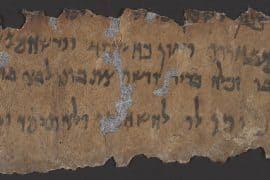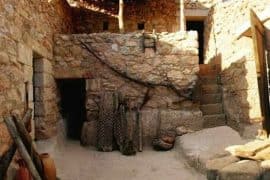Who are you? Are you the Messiah? Or the Prophet? Or Elijah?
We find this series of questions addressed to John the Baptizer in the gospel of John. One of the ideas I explore and develop in my 2006 book, The Jesus Dynasty, was the notion of the expectation of multiple “Messiahs” among the diverse groups of first century CE Judaism. I had no idea it would become sensational–much less controversial. It actually became headline news, with a cover story in USNews & World Report and special segments on ABC’s “Good Morning America,” “20/20” and “Nightline!” along with a special report on “60 Minutes” Australia edition. You can read a synopsis of those stories on-line here.
Jews and Christians today have come to focus on the appearance of a single Messiah–a descendant of the lineage of David who is to reign as king in a messianic kingdom over the entire earth. These expectations are based on a dozen or more texts in the Hebrew Prophets that predict the reign of such a future scion of David (Isaiah 11, Micah 5, Jeremiah 23:5-6). It is worth pointing out, however, that the descriptive term “messiah” is not used in any of these texts–so clearly our theological vocabulary in speaking of “the Messiah” is post-biblical.
One of the Thirteen Principles of the Jewish Faith as formulated by the great Rabbi Moses Maimonides (1135-1204 CE), known by the acronym “the Rambam,” states:
I believe with perfect faith in the coming of the Messiah, and though he may delay I will wait daily for his coming.
The Koren Siddur, trans. and commentary by Rabbi Sir JonathanSacks, p. 204
The Messiah expected is the Davidic King and this affirmation is sung daily in the Yigdal, a song based on the Ramban’s Thirteen Principles. One of the petitions of the Amidah, which is the heart and soul of Jewish daily prayer, beging: “May the offshoot of Your servant David soon flower.”
“The Shemoneh Esreh,” The Koren Siddur, p. 124
Christians affirm that Jesus of Nazareth, crucified, raised from the dead, and ascended to the right hand of God, is this Davidic Messiah or King and that he will return in glory “with the clouds of heaven” in a Second Coming to establish his reign over all the earth.
One question early Christians had to face, in declaring Jesus to be the King Messiah, was who anointed Jesus? Traditionally this was to be done by a Prophet. John the Baptist might be a candidate but we have no record of any such ceremony. Luke has Jesus “anointed of the Spirit,” picking up on Isaiah 61, rather than the traditional anointing with oil. The Ebionites declared that Jesus was made “Son of God,” a term used for the Davidic messiahs, at his baptism by the Voice from heaven.
What few realize is that this expectation of a single Davidic Messiah had not so solidified in the time of Jesus. In text after text, in a diverse variety of of expectations reflected in a scattered range of primary texts from the period we read about any number of redemptive figures. In terms of “Messiahs,” what we find most commonly is not one but two Messiahs who are to usher in the Kingdom of God. One is to be a kingly figure of the royal line of David, but at his side will be a priestly figure, also a Messiah, of the lineage of Aaron from the tribe of Levi. The word “messiah” refers to one who is “anointed” or appointed. In ancient Israel both the kings and the priests were anointed with oil and were thus called “Messiahs.” The verb mashach means to “smear with oil,” and a Moshiach or “Messiah” in English is one so smeared or “anointed” as we say in English. Technically speaking the “first” messiah was Aaron, brother of Moses, anointed with oil by his brother Moses in a formal ceremony that made him the Priest of Israel (Exodus 29:7). The first anointed king was Saul, anointed with oil by the prophet Samuel (1 Samuel 10:1). When Saul lost favor with God David was likewise anointed by Samuel as king (1 Samuel 16:13; 2 Samuel 2:4). Both priest and king were accordingly “messiahs” or anointed ones. This means that the notion of two messiahs was the norm in ancient Israel and this norm, of the dual messiahs was, of course, the one that was projected into the future once the nation begin to be dismantled by the Assyrian and Babylonian invasions in the 8th-6th centuries BCE.
Zechariah, the 6th century BC Hebrew prophet, foretold of a man called “the Branch” who would bear royal honor and sit on his throne, but he adds, “There shall be a priest by his throne with peaceful understanding between the two of them” (Zechariah 6:13). Here is a clear picture of the Davidic King and his counselor, the anointed Priest. Zechariah refers in another vision to “two sons of fresh oil” (i.e., “anointed ones” or “messiahs”) who “stand before the Lord of the whole earth.” He likens them in his vision to two “olive branches” that stand before the Menorah, the seven-branched oil lamp that symbolized God’s Spirit and presence (Zechariah 4).

This ideal vision of two messiahs became a model for many Jewish groups that were oriented toward apocalyptic thinking in the 2nd to 1st centuries BC. The Testament of the Twelve Patriarchs, dating from the 2nd century BC puts things succinctly: “For the Lord will raise up from Levi someone as high priest and from Judah someone as king.” (Testament of Simon 7. 2). Throughout this influential work there is an emphasis that salvation for Israel will come jointly from the tribe of Levi and from the tribe of Judah, the tribe of King David. The Priest Messiah receives more attention than the King Messiah and in many ways he stands superior to the Davidic figure. In fact, the patriarch Judah himself declares, “For to me the Lord gave the kingship and to him the priesthood, and he set the kingship under the priesthood” (Testament of Judah 21:1-2). The Book of Jubilees, coming from about the same period, pronounces a perpetual blessing upon Levi as the progenitor of the priests, and Judah as the father of the “prince” who will rule over the Israel and the nations (Jubilees 31). It seems, based on these texts, that the notion of “Two Messiahs” was the ideal structure of Jewish leadership. It is for this reason that the Maccabeans or Hashmoneans, in the second and first centuries BC, who could claim only the Levitical priestly bloodline, were never really able to effectively establish themselves in the eyes of the populace as “kings,” despite massive political and military power. Ingrained in the Jewish imagination the ideal future in which both a Priest and a King would rule together.
John the Baptizer identified himself as the “messenger” who was to prepare the Way based on a prophecy from the book of Malachi. The version we read in our modern Bibles today is as follows:
“Behold I am sending my messenger to prepare the way before me, and the Lord whom you seek will suddenly come to his temple. The messenger of the covenant in whom you delight—indeed, he is coming says Yahweh of hosts, but who can endure the day of his coming, and who can stand when he appears?” (Malachi 3:1-2).
This translation is based on the standard Hebrew text (Masoretic), the oldest copy of which dates to the 9th century AD. We now have a version of this very passage from Malachi found among the Dead Sea Scrolls. This scroll dates to the 1st century BC, so it is a thousand years older than our standard Hebrew text. Notice carefully the differences in the pronouns:
“Therefore behold I send my messenger, and he shall prepare the way before me. And they will suddenly come to his temple, the Lord whom you seek and the messenger of the covenant, whom you desire; behold he himself comes, says Yahweh of hosts, but who can endure them when they come?”
See Martin Abegg, Peter Flint, and Eugene Ulrich, The Dead Sea Scrolls Bible (New York: HarperSanFrancisco, 1999), p. 477.
This ancient version of Malachi has two figures that are to come jointly—a messenger of the covenant who prepares the Way, but also one called “the Lord whom you seek.” The word translated “Lord” (‘adon) is not the Hebrew name for God—Yahweh or Jehovah, but a word that means a “master” or ruler of some type. It may well be that those who began to flock around Jesus and John the Baptizer were familiar with this version of Malachi with the plural pronouns, and identified them accordingly. This was certainly the understanding of the sectarian community that wrote the Dead Sea Scrolls.
In one of the oldest founding documents of the Dead Sea Scrolls, The Community Rule, the community is expecting the coming of a prophet they called the Teacher, but also the “Messiahs of Aaron and Israel.” They imagined a future in which the Priest Messiah would preside over a “Messianic banquet,” with the King Messiah of Israel, whom they call the “Prince of the congregation,” or the “Branch of David,” as his companion. There are many references in the Dead Sea Scrolls to their fervent expectation that these two Messiahs would appear. As important as the “Branch of David” was to be, they nonetheless had the most extravagant hopes for the coming priest. In a text called the Testament of Levi we read the following:
“He will atone for the sons of his generation and he will be sent to all the sons of his people. His word is like a word of heaven and his teaching is according to the will of God. His eternal sun will shine, and his fire will blaze in all the corners of the earth. Then darkness will disappear from the earth and deep darkness from the dry land” (4Q541).
This amazing text seems to match the high view in which Jesus held his teacher John the Baptizer where he says that “among those born of women there is none greater than John” and that he was not just a “prophet” but “much more than a Prophet” (Luke 7:26-30) In my view the qualification “but he who is least in the kingdom of God is greater than John,” is a later gloss by gospel editors, shocked by the implications that Jesus was here putting John even ahead of himself. It is the very opposite of the theological overlay that our New Testament gospels in their final edited forms project in their effort to make Jesus greater than John. It certainly supports the historical probability that Jesus did view John as his teacher as well as the priestly Messiah of Aaron of whom the prophets had spoken. For those reasons Jesus would have deferred to John’s leadership and direction, a point completely lost in our gospels other than in the collection of Jesus’ earliest teachings that many scholars call Q.
The Dead Sea Scroll community waited a long time for the fulfillment of these central expectations. They had retreated to the Judean desert sometime in the 2nd century BC in response to the prophetic Voice they heard through the prophecies of Isaiah, Daniel, and Malachi. They became convinced that “this was the time” of the preparation of “the Way.” They were the community of the “Last Days” responding to Isaiah’s call to prepare the Way in the desert (Isaiah 40:3). Sometime in the 1st century BCE an influential figure, following Michael Wise’s suggested chronology, there arose among them One who had great spiritual and interpretive gifts. They refer to him in the Scrolls as the “Teacher of Righteousness” (See Oxford Handbook of the Dead Sea Scrolls, “Origins and History of the Teacher’s Movement, pp. 92-122.) We don’t know his name but many events of his life, and even some of his writings, are preserved in the Scrolls. Michael Wise’s wonderful treatment of both the leader and the group, with the provocative title, The First Messiah: Investigating the Savior Before Christ is one I highly recommend. The community saw him as a type of “Prophet like Moses” who had called them into a “new covenant.” They viewed themselves as a remnant group of faithful Israelites who had turned from their sins and separated themselves from the ungodly society around them. They considered the religious establishment of their day, whether Pharisee or Sadducee, to be hopelessly corrupt and compromised. They lived by the strictest interpretation of the laws of the Torah and firmly believed they were living in the “last days.” They believed that their Teacher had given them the definitive inspired interpretation of all the secrets of their prophetic writings.
When their teacher was killed, probably sometime in the mid-1st century BCE, they were convinced the final countdown had begun and that the two Messiahs would soon appear. There are some texts that speak of a final period of “forty years,” following the death of their Teacher. The forty years passed but there is no record in any of the Dead Sea Scrolls that the two Messiahs ever appeared. It was as if all their hopes and expectations were stopped in time and put on hold. For more on these disappointed hopes see my paper “Dead Messiahs Who Don’t Return“). A small group of their community still lived at the settlement we know as Qumran in the 1st century CE, and if they are indeed the people we know as the Essenes, they were scattered in communities all through the land of Israel. They did not die out despite the failure of their original expectations. It is likely that they were partly responsible for keeping alive the hope of the coming of the two Messiahs.
Given these deeply rooted hopes and expectations among these Messianic Jews one can scarcely imagine the excitement and fervor that John the Baptist and Jesus would have stirred as they prepared their next moves in the spring of 27 CE. John as a priest from the tribe of Levi and Jesus as a descendant of David from the tribe of Judah must have stirred the hopes of thousands who had come to expect the arrival of the two Messiahs as a sure sign of the end. Even Herod Antipas soon felt the sting of John the Baptizers’ blistering message of repentance. Christians are prone to imagine a “meek and lowly” Jesus who seldom raised his voice but the evidence will show that he learned well from his teacher and that like John the Baptizer, Jesus’ radical message divided households and villages and shook the religious and political establishment.
I have prepared a special handout titled “Two Messiahs-The Evidence,” for classes and lectures that pulls together all the primary sources and fills out more details. You are welcome to download this, print it out, and use it for your own study but please give credit and do not edit or change what I have written there.









Comments are closed.